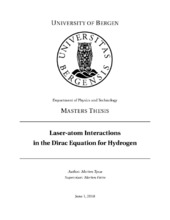Laser-atom Interactions in the Dirac Equation for Hydrogen
Master thesis

View/
Date
2018-06-22Metadata
Show full item recordCollections
- Department of Chemistry [432]
Abstract
The advancements of laser technology make it possible to produce high-energy lasers. It is of interest in many technologies, especially optics, to study how these high-energy lasers interact with atomic or molecular systems. The interaction needs to be modelled in a relativistic manner, due to the high-energy pulse. To get a basic understanding of the dynamics of the interaction, the field of atomic physics often look at the simplest case, hydrogenlike atoms. This thesis models hydrogenlike atoms exposed to high-energy pulses in the Dirac equation and proposes numerical solutions. The high-energy pulse is modelled as a classical wave and is included in the Dirac equation by using the method of minimal coupling. The numerical solutions are within the dipole approximations, as the spatial dependence of the pulse is neglected and thus does not have a magnetic field. The dipole approximation reduces the validity of results with truly high-energy pulses, so it is suggested to go beyond the dipole approximation to work with such pulses. The equation is first solved time-independently and then propagated in time by using the lowest order of the Magnus expansion and Krylov subspace methods. Differential probability distributions for the positive pseudo continuum and probabilities for photoionization in the Dirac equation is compared with its non-relativistic analogue, the Schrödinger equation.